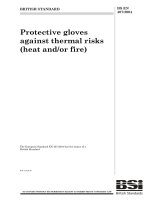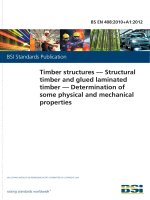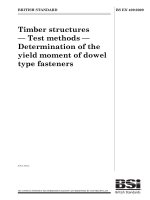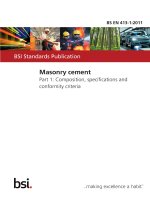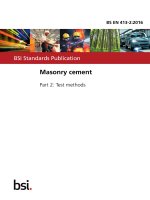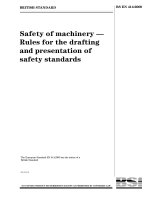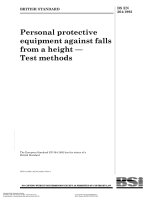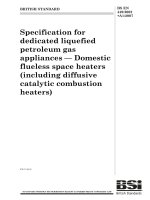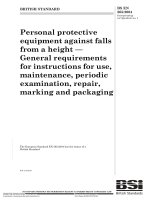Bsi bs en 16783 2017
Bạn đang xem bản rút gọn của tài liệu. Xem và tải ngay bản đầy đủ của tài liệu tại đây (1.02 MB, 21 trang )
BS EN 16783:2017
BSI Standards Publication
Thermal insulation products — Product category rules
(PCR) for factory made and in-situ formed products for
preparing environmental product declarations
BS EN 16783:2017
BRITISH STANDARD
National foreword
This British Standard is the UK implementation of EN 16783:2017.
The UK participation in its preparation was entrusted to Technical
Committee B/540, Energy performance of materials components
and buildings.
A list of organizations represented on this committee can be obtained on
request to its secretary.
This publication does not purport to include all the necessary provisions
of a contract. Users are responsible for its correct application.
ISBN 978 0 580 86698 2
ICS 91.120.10
Compliance with a British Standard cannot confer immunity from
legal obligations.
This British Standard was published under the authority of the
Standards Policy and Strategy Committee on 31 May 2017.
Amendments/corrigenda issued since publication
Date
Text affected
BS EN 16783:2017
EN 16783
EUROPEAN STANDARD
NORME EUROPÉENNE
EUROPÄISCHE NORM
April 2017
ICS 91.120.10
English Version
Thermal insulation products - Product category rules
(PCR) for factory made and in-situ formed products for
preparing environmental product declarations
Produits isolants thermiques - Règles régissant les
catégories de produits (RCP) pour les produits
manufacturés et formés en place, destinées à la
préparation des déclarations environnementales des
produits
Wärmedämmstoffe - Produktkategorieregeln (PCR) für
werkmäßig hergestellte und an der Verwendungsstelle
hergestellte Wärmedämmstoffe zur Erstellung von
Umweltproduktdeklarationen
This European Standard was approved by CEN on 16 January 2017.
CEN members are bound to comply with the CEN/CENELEC Internal Regulations which stipulate the conditions for giving this
European Standard the status of a national standard without any alteration. Up-to-date lists and bibliographical references
concerning such national standards may be obtained on application to the CEN-CENELEC Management Centre or to any CEN
member.
This European Standard exists in three official versions (English, French, German). A version in any other language made by
translation under the responsibility of a CEN member into its own language and notified to the CEN-CENELEC Management
Centre has the same status as the official versions.
CEN members are the national standards bodies of Austria, Belgium, Bulgaria, Croatia, Cyprus, Czech Republic, Denmark, Estonia,
Finland, Former Yugoslav Republic of Macedonia, France, Germany, Greece, Hungary, Iceland, Ireland, Italy, Latvia, Lithuania,
Luxembourg, Malta, Netherlands, Norway, Poland, Portugal, Romania, Serbia, Slovakia, Slovenia, Spain, Sweden, Switzerland,
Turkey and United Kingdom.
EUROPEAN COMMITTEE FOR STANDARDIZATION
C O M I TÉ E URO P É E N D E N O RM ALI S ATI O N
E URO PÄI S C H E S KO M I T E E FÜR N O RM UN G
CEN-CENELEC Management Centre: Avenue Marnix 17, B-1000 Brussels
© 2017 CEN
All rights of exploitation in any form and by any means reserved
worldwide for CEN national Members.
Ref. No. EN 16783:2017 E
BS EN 16783:2017
EN 16783:2017 (E)
Contents
Page
European foreword ....................................................................................................................................................... 3
Introduction .................................................................................................................................................................... 4
1
Scope .................................................................................................................................................................... 5
2
Normative references .................................................................................................................................... 5
3
Terms and definitions ................................................................................................................................... 5
4
Symbols and abbreviations ......................................................................................................................... 5
5
5.1
5.2
5.3
5.4
5.5
5.6
General aspects ................................................................................................................................................ 6
Objective of the complementary PCR for insulation products ...................................................... 6
Types of EPD with respect to life cycle stages covered ...................................................................... 6
Comparability of EPD for construction products ................................................................................ 8
Additional information ................................................................................................................................. 8
Ownership, responsibility and liability for the EPD ........................................................................... 8
Communication formats ............................................................................................................................... 8
6
6.1
6.2
6.3
6.3.1
6.3.2
6.3.3
6.3.4
6.3.5
6.3.6
6.3.7
6.3.8
6.3.9
6.4
6.5
Product Category Rules for LCA ................................................................................................................. 9
Product category ............................................................................................................................................. 9
Life cycle stages and their information modules to be included ................................................... 9
Calculation rules for the LCA ....................................................................................................................... 9
Functional unit ................................................................................................................................................. 9
Declared unit .................................................................................................................................................... 9
Reference service life (RSL)......................................................................................................................... 9
System boundaries ...................................................................................................................................... 10
Criteria for the exclusion of inputs and outputs ............................................................................... 11
Selection of data............................................................................................................................................ 11
Data quality requirements........................................................................................................................ 11
Developing product level scenarios ...................................................................................................... 11
Units .................................................................................................................................................................. 11
Inventory analysis ....................................................................................................................................... 11
Impact assessment....................................................................................................................................... 11
7
Content of the EPD ....................................................................................................................................... 12
8
Project report ................................................................................................................................................ 12
9
Verification and validity of an EPD ........................................................................................................ 12
Annex A (normative) Applications for thermal insulation ........................................................................ 13
Bibliography ................................................................................................................................................................. 16
2
BS EN 16783:2017
EN 16783:2017 (E)
European foreword
This document (EN 16783:2017) has been prepared by Technical Committee CEN/TC 88 “Thermal
insulating materials and products”, the secretariat of which is held by DIN.
This European Standard shall be given the status of a national standard, either by publication of an
identical text or by endorsement, at the latest by October 2017, and conflicting national standards shall
be withdrawn at the latest by October 2017.
Attention is drawn to the possibility that some of the elements of this document may be the subject of
patent rights. CEN shall not be held responsible for identifying any or all such patent rights.
According to the CEN-CENELEC Internal Regulations, the national standards organisations of the
following countries are bound to implement this European Standard: Austria, Belgium, Bulgaria,
Croatia, Cyprus, Czech Republic, Denmark, Estonia, Finland, Former Yugoslav Republic of Macedonia,
France, Germany, Greece, Hungary, Iceland, Ireland, Italy, Latvia, Lithuania, Luxembourg, Malta,
Netherlands, Norway, Poland, Portugal, Romania, Serbia, Slovakia, Slovenia, Spain, Sweden, Switzerland,
Turkey and the United Kingdom.
3
BS EN 16783:2017
EN 16783:2017 (E)
Introduction
This European Standard provides rules for the assessment and quantification of parameters describing
the environmental impact of thermal insulation products to prepare environmental product
declarations.
It defines complementary product category rules for thermal insulation products based on the core
rules for all construction products established in EN 15804. These rules are intended to be used in
conjunction with EN 15804.
These PCR apply to all CEN/TC 88 thermal insulation product Standards (EN 13162 to EN 13171,
EN 14063-1, EN 14064-1, EN 14303 to EN 14309, EN 14313, EN 14314, EN 14315-1 to EN 14320,
EN 14933, EN 14934, prEN 15100-1, EN 15101-1, EN 15501, EN 15599-1, EN 15600-1, EN 15732,
EN 16069) in order to minimize intra-sectoral deviations. These PCR are also valid for thermal
insulation products outside of CEN/TC88 and for thermal insulation products involved in other CEN
TCs.
As in EN 15804, the results from the assessment are expressed following the modularity principle in a
form that allows aggregation (addition) to provide complete information for construction works. These
PCR do not deal with aggregation at the construction works level nor does it describe the rules for
applying the environmental parameters in a construction works assessment.
The reduction in energy used and the reduction of emissions produced during the installed life of
insulation products exceed by far the energy used and in most cases the emissions occurring during the
production, installation and disposal processes. Clause 5.4 of this European Standard provides the rules
for declaration of any such benefits as additional information.
NOTE
4
The titles of the clauses in this European Standard follow the EN 15804 to enhance readability.
BS EN 16783:2017
EN 16783:2017 (E)
1 Scope
This European Standard provides the product category rules (PCR) for Type III environmental
declarations (as in EN 15804) for factory made and in situ thermal insulation products.
Complementary to EN 15804, the PCR described in this European Standard:
— specify the declared unit to be used;
— define the system boundaries for thermal insulation products;
— specify/describe the default scenarios and rules for defining scenarios for certain life cycle
information modules.
These PCR are intended to be used for cradle to gate, cradle to gate with options or cradle to grave
assessment, provided the intention is properly stated in the system boundary description.
2 Normative references
The following documents, in whole or in part, are normatively referenced in this document and are
indispensable for its application. For dated references, only the edition cited applies. For undated
references, the latest edition of the referenced document (including any amendments) applies.
EN 13172, Th erm al in sulation products - Evaluation of con form ity
EN 15804:2012+A1:2013,
Sustain ability of con struction works - En viron m en tal product declaration s -
Core rules for th e product category of con struction products
EN 15942,
Sustain ability of con struction works - En viron m en tal product declaration s - Com m un ication
form at busin ess-to-busin ess
EN 15978,
Sustain ability of con struction works - Assessm en t of en viron m en tal perform an ce of buildin gs -
Calculation m eth od
EN ISO 9229, Th erm al in sulation - Vocabulary (ISO 9229)
3 Terms and definitions
For the purposes of this document, the terms and definitions given in EN ISO 9229,
EN 15804:2012+A1:2013 and the following apply.
3.1
biogenic carbon
carbon derived from/contained in biomass
3.2
biomass
material of biological origin excluding material embedded in geological formations and material
transformed to fossilised material
4 Symbols and abbreviations
For the purpose of this document, the abbreviations given in EN ISO 9229 and EN 15804 and the
abbreviations given in Annex A apply.
5
BS EN 16783:2017
EN 16783:2017 (E)
5 General aspects
5.1 Objective of the complementary PCR for insulation products
As in EN 15804 and the Scope of this European Standard.
5.2 Types of EPD with respect to life cycle stages covered
These PCR identify three main families of EPD:
1) EPD for factory made insulation products;
2) EPD for products intended to be used as in situ insulation products excluding installation;
3) EPD for products to be used as in situ insulation products including installation.
To be in compliance with this European Standard, the declaration of the product stage modules A1-A3 is
required as a minimum for those thermal insulation products that have their applicable technical
characteristics (e.g. thermal resistance) at the factory gate. In addition, for in situ formed thermal
insulation products that establish their applicable technical characteristics after activities on site, the
declaration of Module A5 “installation” of the construction process stage is also required. The
declaration of the modules of the other life cycle stages is optional.
For each of these EPD, mandatory and voluntary stages to be covered are described as in Figure 1.
6
BS EN 16783:2017
EN 16783:2017 (E)
Key
m mandatory
o optional
i
mandatory provision of scenario description and technical information
Figure 1 — Modules
1) EPD for factory made thermal insulation products:
— a cradle to gate EPD: modules A1, A2 and A3 mandatory;
— a cradle to gate EPD with options: modules A1, A2 and A3 mandatory, the other modules
optional (i.e. cradle to gate and selected further life cycle stages) ;
— a cradle to grave EPD: modules A to C mandatory
7
BS EN 16783:2017
EN 16783:2017 (E)
2) EPD for products intended to be used as in situ thermal insulation excluding installation:
— a cradle to gate EPD: modules A1, A2 and A3 mandatory and a mandatory description of a
scenario for module A5 including the necessary activities to obtain the final insulation product
out of the product;
— a cradle to gate EPD with options: modules A1, A2 and A3 mandatory, a mandatory description
of a scenario for module A5 including the necessary activities to obtain the final insulation
product out of the product. The other modules optional (i.e. cradle to gate and selected further
life cycle stages);
— a cradle to grave EPD: modules A to C mandatory.
3) EPDs for products to be used as in situ thermal insulation products including installation:
— a cradle to gate EPD with options: modules A1, A2, A3 and A5 mandatory, the other modules
optional (i.e. cradle to gate and selected further life cycle stages);
— a cradle to grave EPD: modules A to C mandatory.
5.3 Comparability of EPD for construction products
In principle, the comparison of products on the basis of their EPD is defined by the contribution they
make to the environmental performance of the construction works. Consequently comparison of the
environmental performance of construction products using the EPD information shall be based on the
product’s use in and its impacts on the construction works, and shall consider the complete life cycle
(all information modules).
NOTE
This is especially true for insulation products of which their main purpose is to reduce the energy
consumption in the use stage of buildings. Since the reduction of the environmental impacts due to energy savings
during the use stage is in most cases much higher than the environmental impacts of the insulation products
themselves, it makes more sense to focus on good performance on building level during use than on comparing
insulation products.
End use applications are defined in Annex A. Cradle to grave analyses shall describe all relevant
requirements for the end-use application of the product.
5.4 Additional information
As in EN 15804 and additional Annex A of this European Standard.
If benefits of insulation products due to energy saving during the installed life are reported in relation
to the environmental performance of a building, they shall be reported as additional information. The
environmental impacts shall be calculated using EN 15978. The benefit is the difference between the
impacts of at least two insulation levels for the same building considered over the whole life cycle. The
scenarios shall be fully described in the EPD and sufficient information given to the verifier to verify
this.
5.5 Ownership, responsibility and liability for the EPD
A manufacturer or a group of manufacturers are the sole owners and have liability and responsibility
for an EPD.
5.6 Communication formats
The communication format of the EPD shall be in accordance with EN 15942.
8
BS EN 16783:2017
EN 16783:2017 (E)
6 Product Category Rules for LCA
6.1 Product category
The product category referred to in this document includes all the thermal insulation products.
6.2 Life cycle stages and their information modules to be included
As in EN 15804 and in addition Clause 5.2 of this European Standard.
6.3 Calculation rules for the LCA
6.3.1 Functional unit
As in EN 15804 and in addition clause 5.2 of this European Standard, a functional unit shall contain the
R-value for the applications as listed in Annex A. If the R-value is not relevant for a specific civil
engineering application, the relevant function for that application shall be defined instead.
6.3.2 Declared unit
The declared unit is defined as:
For batts, boards and similar:
1 m 2 thermal insulation product for a specific RD -value of the product as placed on the market intended
to be used for any of the application(s) listed in Annex A or used as generic insulation. Calculation rules
can be added for other RD -values.
Conversion factors may be added to translate from m 2 and R-value to one or more of the other required
unit types in EN 15804: item, mass (kg), length (m), volume (m 3 ).
For pipe sections:
1 m 1 thermal insulation pipe section product with the declared lambda, diameter and thickness, as
placed on the market or used to insulate a pipe. Calculation rules can be supplied to account for the
various thicknesses, diameters and densities.
Conversion factors may be added to translate from m 1 to one or more of the other required unit types in
EN 15804: item, mass (kg), area (m 2 ), volume (m 3 ).
For civil engineering applications:
1 m 3 thermal insulation product with the declared lambda, as placed on the market intended to be used
for the application(s) listed in Annex A or used as generic insulation.
Conversion factors may be added to translate from m 3 to one or more of the other required unit types in
EN 15804: item, mass (kg), area (m 2 ).
Grouping of products shall follow the rules of EN 13172, but should ensure that any deviations due to
intra- or extrapolation are less than 25 %, as described in Clause 6.3.6 of this European Standard.
6.3.3 Reference service life (RSL)
As in EN 15804.
A RSL linked to a specific application defined in Annex A can be declared. The parameters used to
determine the RSL such as in use conditions etc., shall be declared in line with the applicable ISO
standards (as in EN 15804).
NOTE
The thermal performance characteristics of thermal insulation products are usually based on a
minimum of 50 years.
9
BS EN 16783:2017
EN 16783:2017 (E)
6.3.4 System boundaries
6.3.4.1 General
As in EN 15804.
6.3.4.2 Product stage
As in EN 15804.
6.3.4.3 Construction stage
For the A4 module:
If module A4 is addressed in the EPD for transport from the production gate to the construction site, the
following information shall be provided to specify the transport scenarios used or to support
development of the scenarios at the construction works level:
— values that are based on real and verifiable delivery data;
—
the capacity of the truck used in the calculation, which by default is defined by the volume that can
be loaded;
— the average distance and capacity utilization;
— the return transport scenario, which by default is “empty return”.
For the A5 module:
As in EN 15804.
Ancillary materials shall be taken into account with a scenario linked to one of the applications defined
in Annex A.
Waste percentage can be determined or a default waste percentage of 2 % can be taken for the
insulation products during installation.
If equipment is used to install the insulation product, the environmental impact of using this equipment
(e.g. energy, additives, lubricants, cleaning, etc.) shall be taken into account.
6.3.4.4 Use stage
6.3.4.4.1 General
As in EN 15804.
6.3.4.4.2 B1 to B5 Use stage information modules related to the building fabric
B1 to B5 modules are only possible if linked to one or more applications listed in Annex A.
— B1: as in EN 15804
— B2: Thermal insulation products do not require maintenance during use in standard conditions and
if correctly applied. The default environmental impacts are in this case assumed to be zero;
— B3: Thermal insulation products are not repaired during use in standard conditions and if correctly
applied. The default environmental impacts are in this case assumed to be zero;
— B4:as in EN 15804;
— B5: as in EN 15804.
10
BS EN 16783:2017
EN 16783:2017 (E)
6.3.4.4.3 B6 to B7 Use stage information modules related to the operation of the building
— B6: Insulation products do not use energy during use of the building. The default environmental
impacts are zero;
NOTE
Thermal insulation products reduce the energy consumption of buildings or industrial installations
and thus have a positive contribution to the environment. See Clause 5.4 Additional information.
— B7: Insulation products do not use water during use of the building. The default environmental
impacts are zero.
6.3.4.5 End-of-life stage
As in EN 15804.
In addition, demolition and deconstruction scenarios shall be justified and can vary with the different
applications listed in Annex A and with geographical location.
Thermal insulation products can be sorted and separated for recycling or for energy recovery. Scenarios
can vary with the different applications listed in Annex A and with geographical location.
6.3.4.6 Benefits and loads beyond the product system boundary in module D
Recycling and recovery scenarios shall be justified and can vary with the different applications listed in
Annex A.
6.3.5 Criteria for the exclusion of inputs and outputs
As in EN 15804.
6.3.6 Selection of data
As in EN 15804.
In addition, grouping of products and declaring average values is allowed without reporting differences,
if the differences in each impact category are lower than 25 %. In other cases the differences in the
impact categories shall be reported together with average values.
6.3.7 Data quality requirements
As in EN 15804.
6.3.8 Developing product level scenarios
As in EN 15804.
6.3.9 Units
As in EN 15804.
6.4 Inventory analysis
As in EN 15804. Further guidance can also be found in CEN/TR 16970.
6.5 Impact assessment
As in EN 15804.
Further guidance on how to deal with biogenic carbon is given in CEN/TR 16970.
11
BS EN 16783:2017
EN 16783:2017 (E)
7 Content of the EPD
As in EN 15804.
In addition to EN 15804:2012+A1:2013, 7.2.2 “Rules for declaring LCA information per module”:
Module A5 “installation” shall be addressed in the EPD for in situ formed thermal insulation products
that establish their applicable technical characteristics after activities on site.
In addition to EN 15804:2012+A1:2013, 7.3.2.2 “A5, Installation in the building”: As module A5 shall be
declared for in situ formed thermal insulation products that establish their applicable technical
characteristics after activities on site, the calculated parameters addressed to Module A5 shall be
specified according to EN 15804:2012+A1:2013, Table 8 and be included in the EPD.
8 Project report
As in EN 15804.
9 Verification and validity of an EPD
As in EN 15804.
NOTE
As mentioned in Annex ZA of the thermal insulation Standards (EN 13162 to EN 13171, EN 14063–1,
EN 14064–1, EN 14303 to EN 14309, EN 14313, EN 14314, EN 14315–1 to EN 14320, EN 14933, EN 14934,
EN 15100–1, EN 15101–1, EN 15501, EN 15599–1, EN 15600–1, EN 15732, EN 16069), System 3 level is valid for
all properties of thermal insulation products, except reaction to fire in some cases.
12
BS EN 16783:2017
EN 16783:2017 (E)
Annex A
(normative)
Applications for thermal insulation
This Standard recommends to EPD owners to provide additional technical information, describing
technical conditions underlying scenarios and characterizing the product’s technical and functional
performance during the optional life cycle stages „construction, use and the end of life“ for any scenario
based calculations of the LCA based parameters.
NOTE
Type of anchors, glues, protection layers.
Table A.1 — Applications for thermal insulation in buildings
Area of
Designation
Application
DAD
DAA
DUK
DZ
Ceiling, Roof,
DI
floor
DEO
DES
VR
Wall
WAB
WAA
WAP
WZ
WH
WI
WTH
WTR
Perimeter
PW
PB
FI
Application description
External insulation of warm pitched roof or ceiling insulation, protected
against weathering, insulation under cover
External insulation of flat roof or ceiling, protected against weathering,
insulation under water proofing
External insulation of the roof, exposed to the weather (inverted roof)
Insulation between the rafters, two-shell roof, top floor ceiling not readily
walkable but accessible
Interior insulation of the ceiling (underside) or the roof, insulation under
the rafters / supporting structure, false ceiling etc.
Interior insulation of the ceiling or floor plate (top side) below floor
screed without acoustic dampening requirements
Interior insulation of the ceiling or floor plate (top side) below screed
with acoustic dampening requirements
Thermal insulation between rafters, ventilated space directly above
thermal insulation
External wall insulation behind covers (incl. ventilated faỗades)
External wall insulation behind seal
External Thermal Insulation Composite System with render
Insulation of double-leaf walls, cavity wall insulation
Insulation of wood frame and wood panel construction
Interior wall insulation (insulation of walls from inside)
Insulation between the house partition walls with sound insulation
requirements (between adjacent houses)
Insulation of partitioning walls (within one house)
External thermal insulation of walls in contact with soil (outside of the
water proofing)
External thermal insulation under the floor panel in contact with soil
(outside of water proofing)
Thermal insulation as horizontal ground frost insulation
13
BS EN 16783:2017
EN 16783:2017 (E)
Table A.3 — Applications for thermal insulation in civil engineering
Area of
Application
Civil
Engineering
Designation
Application description
CI
Civil Engineering
LWF
Light-weight fill
ILB
Insulation under load-bearing structure
15
BS EN 16783:2017
EN 16783:2017 (E)
Bibliography
EN 13162, Th erm al in sulation products for buildin gs – Factory m ade m in eral wool (MW) products –
Specification
EN 13163, Th erm al in sulation products for buildin gs – Factory m ade products of expan ded polystyren e
(EPS) – Specification
EN 13164, Th erm al in sulation products for buildin gs – Factory m ade products of extruded polystyren e
foam (XPS) – Specification
EN 13165, Th erm al in sulation products for buildin gs – Factory m ade rigid polyureth an e foam (PUR)
products – Specification
EN 13166, Th erm al in sulation products for buildin gs – Factory m ade products of ph en olic foam (PF) –
Specification
EN 13167, Th erm al in sulation products for buildin gs – Factory m ade cellular glass (CG) products –
Specification
EN 13168, Th erm al in sulation products for buildin gs – Factory m ade wood wool (WW) products –
Specification
EN 13169, Th erm al in sulation products for buildin gs – Factory m ade products of expan ded perlite (EPB) –
Specification
EN 13170, Th erm al in sulation products for buildin gs – Factory m ade products of expan ded cork (ICB) –
Specification
EN 13171, Th erm al in sulatin g products for buildin gs – Factory m ade wood fibre (WF) products –
Specification
EN 14063-1, Therm al in sulation products for buildings - In -situ form ed expan ded clay ligh tweigh t
aggregate products - Part 1 : Specification for th e loose-fill products before in stallation
EN 14064-1, Th erm al in sulation products for buildings - In -situ form ed loose-fill m in eral wool (MW)
products - Part 1 : Specification for th e loose-fill products before in stallation
EN 14303, Th erm al in sulation products for buildin g equipm en t an d in dustrial in stallation s - Factory m ade
m in eral wool (MW) products - Specification
EN 14304, Th erm al in sulation products for buildin g equipm en t an d in dustrial in stallation s - Factory m ade
flexible elastom eric foam (FEF) products - Specification
EN 14305, Th erm al in sulation products for buildin g equipm en t an d in dustrial in stallation s - Factory m ade
cellular glass (CG) products - Specification
EN 14306, Th erm al in sulation products for buildin g equipm en t an d in dustrial in stallation s - Factory m ade
calcium silicate (CS) products - Specification
EN 14307, Th erm al in sulation products for buildin g equipm en t an d in dustrial in stallation s - Factory m ade
extruded polystyren e foam (XPS) products - Specification
16
BS EN 16783:2017
EN 16783:2017 (E)
EN 14308, Th erm al in sulation products for buildin g equipm en t an d in dustrial in stallation s - Factory m ade
rigid polyureth an e foam (PUR) an d polyisocyan urate foam (PIR) products - Specification
EN 14309, Th erm al in sulation products for buildin g equipm en t an d in dustrial in stallation s - Factory m ade
products of expan ded polystyren e (EPS) - Specification
EN 14313, Th erm al in sulation products for buildin g equipm en t an d in dustrial in stallation s - Factory m ade
polyeth ylen e foam (PEF) products - Specification
EN 14314, Th erm al in sulation products for buildin g equipm en t an d in dustrial in stallation s - Factory m ade
ph en olic foam (PF) products - Specification
EN 14315-1, Therm al in sulatin g products for buildings - In -situ form ed sprayed rigid polyureth an e (PUR)
an d polyisocyan urate (PIR) foam products - Part 1 : Specification for th e rigid foam spray system
before in stallation
EN 14316-1, Th erm al in sulation products for buildings - In -situ th erm al in sulation form ed from expan ded
perlite (EP) products - Part 1 : Specification for bon ded an d loose-fill products before in stallation
EN 14317-1, Th erm al in sulation products for buildings - In -situ th erm al in sulation form ed from exfoliated
verm iculite (EV) products - Part 1 : Specification for bon ded an d loose-fill products before
in stallation
EN 14318-1, Th erm al in sulatin g products for buildings - In -situ form ed dispen sed rigid polyureth an e
(PUR) an d polyisocyan urate (PIR) foam products - Part 1 : Specification for th e rigid foam
dispen sed system before in stallation
EN 14319-1, Th erm al in sulatin g products for building equipm en t an d in dustrial in stallation s - In -situ
form ed dispen sed rigid polyureth an e (PUR) an d polyisocyan urate foam (PIR) products - Part 1 :
Specification for th e rigid foam dispen sed system before in stallation
EN 14320-1, Th erm al in sulatin g products for building equipm en t an d in dustrial in stallation s - In -situ
form ed sprayed rigid polyureth an e (PUR) an d polyisocyan urate foam (PIR) products - Part 1 :
Specification for th e rigid foam spray system before in stallation
prEN 15100-1, Th erm al in sulatin g products for buildin gs - In -situ form ed urea-form aldeh yde foam (UF)
products - Part 1 : Specification for th e foam system before in stallation
EN 15101-1, Th erm al in sulation products for buildings - In -situ form ed loose fill cellulose (LFCI) products Part 1 : Specification for th e products before in stallation
EN 15501, Th erm al in sulation products for buildin g equipm en t an d in dustrial in stallation s - Factory m ade
expan ded perlite (EP) an d exfoliated verm iculite (EV) products - Specification
EN 15599-1, Therm al in sulation products for building equipm en t an d in dustrial in stallation s - In -situ
th erm al in sulation form ed from expan ded perlite (EP) products - Part 1 : Specification for bon ded
an d loose-fill products before in stallation
EN 15600-1, Th erm al in sulation products for building equipm en t an d in dustrial in stallation s - In -situ
th erm al in sulation form ed from exfoliated verm iculite (EV) products - Part 1 : Specification for
bon ded an d loose-fill products before in stallation
EN 16069, Th erm al in sulation products for buildin gs – Factory m ade products of polyeth ylen e foam (PEF)
– Specification
17
BS EN 16783:2017
EN 16783:2017 (E)
EN 15732, Ligh t weigh t fill an d th erm al in sulation products for civil en gin eering application s (CEA) Expan ded clay ligh tweigh t aggregate products (LWA)
EN 14933, Th erm al in sulation an d ligh t weigh t fill products for civil en gin eering application s - Factory
m ade products of expan ded polystyren e (EPS) - Specification
CEN/TR 16970, Sustain ability of con struction works - Guidan ce for th e im plemen tation of EN 1 5804
18
This page deliberately left blank
NO COPYING WITHOUT BSI PERMISSION EXCEPT AS PERMITTED BY COPYRIGHT LAW
British Standards Institution (BSI)
BSI is the national body responsible for preparing British Standards and other
standards-related publications, information and services.
BSI is incorporated by Royal Charter. British Standards and other standardization
products are published by BSI Standards Limited.
About us
Reproducing extracts
We bring together business, industry, government, consumers, innovators
and others to shape their combined experience and expertise into standards
-based solutions.
For permission to reproduce content from BSI publications contact the BSI
Copyright & Licensing team.
The knowledge embodied in our standards has been carefully assembled in
a dependable format and re f ned through our open consultation process.
Organizations of all sizes and across all sectors choose standards to help
them achieve their goals.
Information on standards
We can provide you with the knowledge that your organization needs
to succeed. Find out more about British Standards by visiting our website at
bsigroup.com/standards or contacting our Customer Services team or
Knowledge Centre.
Buying standards
You can buy and download PDF versions of BSI publications, including British
and adopted European and international standards, through our website at
bsigroup.com/shop, where hard copies can also be purchased.
If you need international and foreign standards from other Standards Development
Organizations, hard copies can be ordered from our Customer Services team.
Copyright in BSI publications
All the content in BSI publications, including British Standards, is the property
of and copyrighted by BSI or some person or entity that owns copyright in the
information used (such as the international standardization bodies) and has
formally licensed such information to BSI for commercial publication and use.
Save for the provisions below, you may not transfer, share or disseminate any
portion of the standard to any other person. You may not adapt, distribute,
commercially exploit, or publicly display the standard or any portion thereof in any
manner whatsoever without BSI’s prior written consent.
Storing and using standards
Standards purchased in soft copy format:
•
A British Standard purchased in soft copy format is licensed to a sole named
user for personal or internal company use only.
•
The standard may be stored on more than 1 device provided that it is accessible
by the sole named user only and that only 1 copy is accessed at any one time.
•
A single paper copy may be printed for personal or internal company use only.
Standards purchased in hard copy format:
•
A British Standard purchased in hard copy format is for personal or internal
company use only.
•
It may not be further reproduced – in any format – to create an additional copy.
This includes scanning of the document.
If you need more than 1 copy of the document, or if you wish to share the
document on an internal network, you can save money by choosing a subscription
product (see ‘Subscriptions’).
Subscriptions
Our range of subscription services are designed to make using standards
easier for you. For further information on our subscription products go to
bsigroup.com/subscriptions.
With British Standards Online (BSOL) you’ll have instant access to over 55,000
British and adopted European and international standards from your desktop.
It’s available 24/7 and is refreshed daily so you’ll always be up to date.
You can keep in touch with standards developments and receive substantial
discounts on the purchase price of standards, both in single copy and subscription
format, by becoming a BSI Subscribing Member.
PLUS is an updating service exclusive to BSI Subscribing Members. You will
automatically receive the latest hard copy of your standards when they’re
revised or replaced.
To f nd out more about becoming a BSI Subscribing Member and the bene f ts
of membership, please visit bsigroup.com/shop.
With a Multi-User Network Licence (MUNL) you are able to host standards
publications on your intranet. Licences can cover as few or as many users as you
wish. With updates supplied as soon as they’re available, you can be sure your
documentation is current. For further information, email
Revisions
Our British Standards and other publications are updated by amendment or revision.
We continually improve the quality of our products and services to bene f t your
business. If you f nd an inaccuracy or ambiguity within a British Standard or other
BSI publication please inform the Knowledge Centre.
Useful Contacts
Customer Services
Tel: +44 345 086 9001
Email (orders): orders@bsigroup. com
Email (enquiries): cservices@bsigroup. com
Subscriptions
Tel: +44 345 086 9001
Email: subscriptions@bsigroup. com
Knowledge Centre
Tel: +44 20 8996 7004
Email: knowledgecentre@bsigroup. com
Copyright & Licensing
Tel: +44 20 8996 7070
Email: copyright@bsigroup. com
BSI Group Headquarters
389 Chiswick H igh Road Lond on W4 4AL U K
